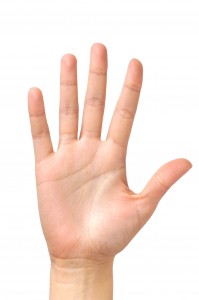 Webbing of the human finger, an occurrence commonly known as webbed fingers or toes, is called syndactyly, and is a condition wherein fingers are joined or adjacently grown together. It is not brought about with the fingers combining together in the uterus; rather, it is a result of a failure of the fingers to separate during six to eight weeks of a child in a uterus, also known as longitudinal interdigital necrosis. This condition is one of the most frequently-occurring hand deformities among newborn infants. It may either be an isolated anomaly in the child’s development, or a part of a syndrome. Isolated cases are usually inherited as an autosomal-dominant disorder.
Webbing of the human finger, an occurrence commonly known as webbed fingers or toes, is called syndactyly, and is a condition wherein fingers are joined or adjacently grown together. It is not brought about with the fingers combining together in the uterus; rather, it is a result of a failure of the fingers to separate during six to eight weeks of a child in a uterus, also known as longitudinal interdigital necrosis. This condition is one of the most frequently-occurring hand deformities among newborn infants. It may either be an isolated anomaly in the child’s development, or a part of a syndrome. Isolated cases are usually inherited as an autosomal-dominant disorder.
There are five types of syndactyly: zygodactyly, which occurs between the middle and ring fingers; synpolydactyly, similar to the previously mentioned type with an added duplication of the ring finger in between the involved fingers; ring-small syndactyly, a bilateral type wherein the distal phalanges are joined; haas-type syndactyly, where all digits are fused together with some occurrence of a sixth metacarpal and phalanges; and finally, a fifth rare type where both the long and ring fingers and the second and third toes are syndactylized. The fourth and fifth metatarsals and metacarpals may be fused.
Genetic counseling for this condition may be difficult, though. The genes in this condition are not easy to penetrate, and their occurrences vary. At that note, every child waiting to be born carries a fifty percent probability of having this deformity, but occurrence is not so consistent through generations.
One thing is certain, however: paternal genes bear stronger influence A child’s hand may well be different from either parent’s hand, or neither parent may have a syndactyly, but evidence still suggests that paternal genes have a stronger influence than their maternal counterparts.
Repairing Webbed Digits
Webbed finger or toe repair is a corrective or reconstructive surgery undertaken to fix webbed fingers or toes. It is done by partially separating the union of two or more fingers or toes, primarily focusing on the skin connection between the two for simpler types of syndactyly, and then adding a skin graft from the groin. There are cases where there is a fusion of bones, nerves, blood vessels, and tendons in the affected digits, also known as complex syndactyly, and the procedure would then involve the separation of the said body parts.
Lasting from two to four hours, there are various means to perform webbed finger repair based on the features of the affected body part and the surgeon’s experience. Zigzag incisions that cross back and forth among the fingers or toes are usually done to avoid interference of scars to digit growth.
The procedure requires the use of general anesthesia. The surgeon will mark the skin on areas that need repair, and will make incisions based on the markings, with which flaps at the sides of the digits can be lifted. Afterwards, the flaps are seamed back, leaving spaces where skin cannot cover the flesh anymore.
Full thickness skin grafts that are usually taken from the groin area can be used to fill these areas. Afterward, the limbs and digits are temporarily immobilized to heal with the use of casts or dressings.
